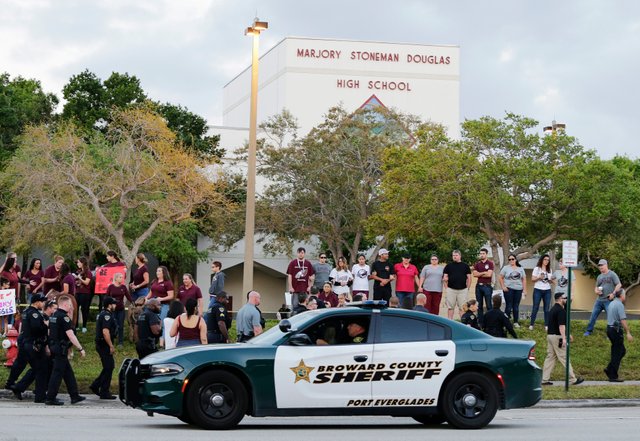School shootings are extraordinarily rare. Why is fear of them driving policy?

One point we've made over and over is that most Americans are terrible at appraising risks, and the media makes it worse. Certain kinds of risk are newsworthy (shootings) while other kinds of risks don't get much mention (dying in a fall), if any.
Thanks to media reports some kinds of risks seem to be much bigger than they actually are and people demand attention be paid to small risks while ignoring significantly larger risks. In spite of what you think, driving to work is more a threat than terrorism, bathtubs are more dangerous than school shooters.
David Ropeik, of Harvard, writes in the Washington Post looks at the risks of dying in a school shooting:
"The Education Department reports that roughly 50 million children attend public schools for roughly 180 days per year. Since Columbine, approximately 200 public school students have been shot to death while school was in session, including the recent slaughter at Marjory Stoneman Douglas High School in Parkland, Fla. (and a shooting in Birmingham, Ala., on Wednesday that police called accidental that left one student dead). That means the statistical likelihood of any given public school student being killed by a gun, in school, on any given day since 1999 was roughly 1 in 614,000,000. And since the 1990s, shootings at schools have been getting less common.
The chance of a child being shot and killed in a public school is extraordinarily low. Not zero — no risk is. But it’s far lower than many people assume, especially in the glare of heart-wrenching news coverage after an event like Parkland. And it’s far lower than almost any other mortality risk a kid faces, including traveling to and from school, catching a potentially deadly disease while in school or suffering a life-threatening injury playing interscholastic sports. "
Yes, school athletics is more dangerous than school shooters, but it's particular good for television ratings.
Ropiek emphasizes points we've tried to emphasize. These wrong assumptions can push people into making policy decisions that increase risks. For instance, "rare plane crashes scare travelers into their cars and trucks (a statistically riskier way to get around.)"
I read reports of teachers who are terrorizing children by having drills to duck and cover and how to hide from the gunmen. The number of children traumatize by gun drills vastly exceeds the number who were present during a shooting. Ropiek writes:
"Think about the psychological effects on kids from all those lessons about when to run, how to hide, directions from their parents to call home if a shooting occurs. A few children have even brought guns to school, saying they wanted to protect their classmates . What happens to children’s ability to learn if they spend their time in the classroom wondering, even if only occasionally, who’s going to burst in and open fire? What does the chronic stress of such worry do to their health? What do constant messages of potential danger in a place that’s supposed to be safe do to their sense of security in the world? Across the population of public school children in the United States, fear of this extraordinarily rare risk is almost certainly doing far more overall harm than have the shootings themselves, horrendous as they are."
Because most people are completely crippled with cowardice.
Because the MSmockingbirdM is very good at creating and driving fear.
Of course this whole thing was to move america one step closer to disarmament. Because, the govern-cement's biggest fear is an angry public, with guns, finding out about all the bad things they have been doing.
So, how many senators had bills ready to be pushed onto the floor?
How many journalists had stories ready to publish?
... just in case another shooting happened.
Did the crisis actors show up before or after the alleged shooting?
absolutely it is a function of media. We as humans do this goofy thing where we interpret hearing about something commonly as something that actually occurs commonly. Cognitively this is a great heuristic to use in life, but can be hijacked with the 24/7 feed of national and international news. This can also apply to hearing about the exact same thing repeatedly. Best thing to do is to detach from all the narratives, emotion and actually look at the number. It is not nearly as easy (but still possible) to juke the stats and it is easy to correct this when it happens.
Congratulations! This post has been upvoted from the communal account, @minnowsupport, by libertyLOL from the Minnow Support Project. It's a witness project run by aggroed, ausbitbank, teamsteem, theprophet0, someguy123, neoxian, followbtcnews, and netuoso. The goal is to help Steemit grow by supporting Minnows. Please find us at the Peace, Abundance, and Liberty Network (PALnet) Discord Channel. It's a completely public and open space to all members of the Steemit community who voluntarily choose to be there.
If you would like to delegate to the Minnow Support Project you can do so by clicking on the following links: 50SP, 100SP, 250SP, 500SP, 1000SP, 5000SP.
Be sure to leave at least 50SP undelegated on your account.
Because school shootings implicitly involve children, they can be a powerful emotional cudgel. Standing of the graves of children, politicians and demagogues can shout (and often have been videotaped) literally anything to get their agenda put on the cultural fast track. MAD (Mothers Against Drunk driving) did it with alcohol limits at the federal level. Using something cute and cuddly being annihilated is a powerful tool to stir emotion and shift conversation. Read Saul Alinsky's Rules for Radicals.
I wrote about it a couple years ago!
http://www.libertylol.com/libertyblog/saul-alinsky-and-his-rules-for-radicals